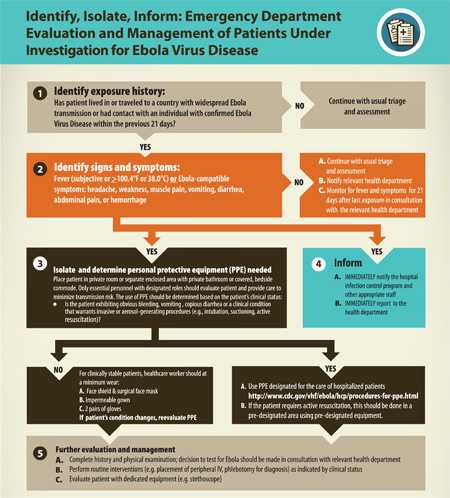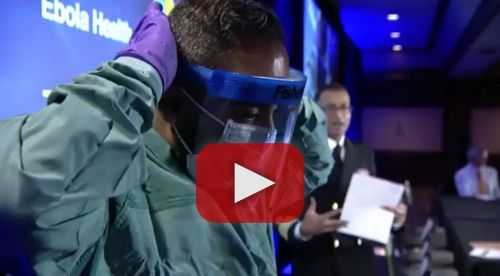Identify, Isolate, Inform: Emergency Department Evaluation and Management for Patients Under Investigation (PUIs) for Ebola Virus Disease (EVD)
The recommendations on this page are no longer in effect and will not be updated. For information on screening patients for Ebola, see FAQs on Screening for Ebola Virus Disease. For information on caring for survivors of Ebola, see Interim Guidance for Management of Survivors of Ebola Virus Disease in U.S. Healthcare Settings and Messages for the Care of Survivors of Ebola.
Page Summary
Who this is for: Emergency department (ED) staff
What this is for: Guidance to help ED staff evaluate whether or not a patient might have Ebola virus disease (EVD). Staff members should use this information to follow the 3 steps within the “Identify, Isolate, and Inform” strategy. CDC recommends that staff members screen all patients with travel histories, exposure, or clinical symptoms that might suggest the person could have EVD.
How this relates to other guidance: Given that people with a risk of exposure to Ebola virus are being closely monitored by state and local health departments and directed to designated facilities for evaluation should they become ill, it is unlikely that patients with EVD will arrive unannounced at an outpatient setting. Nonetheless, ED staff should be familiar with this guidance and prepared to implement it. Refer to additional guidance documents on personal protective equipment (PPE) and environmental infection prevention and control recommendations for patients under investigation (PUIs) for EVD.
Key Points
- Most patients with fever and other symptoms coming to the ED don’t have EVD, but it is important that staff members know how to identify and manage patients who might have EVD.
- Staff members should be ready to take 3 steps: Identify, Isolate, and Inform.
- Ask every patient if, in the last 21 days, they traveled internationally or had contact with someone with EVD.
- If a patient appears to be at risk for EVD, isolate the patient immediately, put on PPE, and notify the facility’s infection control team and health department.

Emergency Department PPE Demo
Reference time span from 1:10:30 to 1:20:39
Background: Procedures in the accompanying algorithm provide guidance on ED evaluation and management of PUIs. Guidance in this document reflects lessons learned from the recent experiences of U.S. hospitals caring for patients with EVD.
The risk of transmission of Ebola virus from a patient to a healthcare worker depends upon the likelihood the patient will have EVD combined with the likelihood and degree of exposure to infectious blood or body fluids. That risk depends on the severity of disease. Severe illness is strongly associated with high levels of virus production. In addition, close contact with the patient and invasive medical care can increase opportunities for transmission.
In general, the majority of febrile patients presenting to the ED do not have EVD, and the risk posed by patients with early, limited symptoms is lower than that from a patient hospitalized with severe EVD. Nevertheless, because early symptoms of EVD are similar to other febrile illnesses, triage and evaluation processes in the ED should consider and systematically assess patients for the possibility of EVD. Healthcare facilities should implement administrative and environmental controls (for example, designated area for further evaluation of PUIs) and provide onsite management and oversight on the safe use of PPE. Best practice would include continuous safety checks through direct observation of healthcare workers during the process of putting on (donning) and removing (doffing) PPE.
Triage Recommendations:
- Immediately upon a person’s entrance to the ED, or in advance of entry if possible, a relevant exposure history should be taken including exposure criteria of whether the patient has traveled internationally or had contact with an individual with EVD within the previous 21 days. Because the signs and symptoms of EVD may be nonspecific and are present in other infectious and noninfectious conditions that are more frequently encountered in the United States, relevant exposure history should be first elicited to determine whether EVD should be considered further. If the patient is unable to provide history due to clinical condition or other communication barrier, history should be elicited from the next most reliable source (family, friend, EMS provider).
- Patients who meet the exposure criteria should be further questioned regarding the presence of signs or symptoms compatible with EVD. These include: fever (subjective or ≥100.4°F or 38.0°C) or headache, fatigue, weakness, muscle pain, vomiting, diarrhea, abdominal pain, or hemorrhage (bleeding gums, blood in urine, nose bleeds, coffee ground emesis or melena).
All patients should be routinely managed using precautions to prevent any contact with blood or body fluids. If an exposure history is unavailable, clinical judgment should be used to determine whether to empirically implement the following protocol. If a relevant exposure history is reported and signs or symptoms consistent with EVD are present, the following measures should be implemented IMMEDIATELY:
- Isolate the patient in a private room or separate enclosed area with private bathroom or covered, bedside commode and adhere to procedures and precautions designed to prevent transmission by direct or indirect contact (dedicated equipment, hand hygiene, and restricted patient movement). If the patient is arriving by EMS transport, the ED should be prepared to receive the patient in a designated area (away from other patients) and have a process in place for safely transporting the patient on the stretcher to the isolation area with minimal contact with non-essential healthcare workers or the public.
To minimize transmission risk, only essential healthcare workers with designated roles should provide patient care. A log should be maintained of all personnel who enter the patient’s room. All healthcare workers who have contact with the patient should put on appropriate PPE based on the patient’s clinical status. If the patient is exhibiting obvious bleeding, vomiting, copious diarrhea or a clinical condition that warrants invasive or aerosol-generating procedures (intubation, suctioning, active resuscitation), PPE designated for the care of hospitalized patients as outlined in CDC guidance* should be used. If the patient requires active resuscitation, this should be done in a pre-designated area using equipment dedicated to the patient. If these signs and symptoms are not present and the patient is clinically stable, healthcare workers should at a minimum wear: 1) face shield, 2) surgical face mask, 3) Single-use, fluid-resistant gown and 4) two pairs of examination gloves where the outer gloves have extended cuffs. All equipment used in the care of these patients should not be used for the care of other patients until appropriate evaluation and decontamination.
- Notify the Hospital Infection Control Program and other appropriate staff and report to the relevant local health department immediately of patients with EVD exposure history regardless of symptoms.
- Once appropriate PPE has been put on, continue obtaining additional history and performing physical examination and routine diagnostics and interventions which may include placement of peripheral IV and phlebotomy. The decision to test a patient for EVD should be made in consultation with the relevant local health department. Patient evaluation should be conducted with dedicated equipment as required for patients on transmission-based precautions.
Developed in collaboration with ACEP and ENA.
- Page last reviewed: March 22, 2016
- Page last updated: December 29, 2015
- Content source:




 ShareCompartir
ShareCompartir
